Over centuries, marijuana in some form or other has been used in India. Its use was made illegal in 1985. That decision, which is now over 30-years old, is being revisited, with the government looking at legalising its use for medical purposes.
Women and Child Development Minister Maneka Gandhi suggested legalising marijuana for medical purposes on the lines of the practice adopted by some developed countries like the US to curb drug abuse. The suggestion was made by Gandhi at a meeting of a group of ministers (GOM), which examined the draft cabinet note National Drug Demand Reduction Policy, reported the
Indian Express
Prime minister Narendra Modi has directed the GoM to examine the draft policy for drug demand reduction which seeks to address the problem of drug and substance abuse in the country.
The Rajiv Gandhi government had clubbed bhang and ganja, derived from the hemp plant, with hard drugs like hard drugs and cocaine in the Narcotic Drugs and Psychotropic Substances (NDPS) Act, with the punishment for violation being 10 years and more.
Drug abuse is a global phenomenon and the use of dependence producing substances is universal. “In India, the use of opium and cannabis has been in existence since long ago. In the last three decades, however new drugs like heroin, amphetamine type stimulants (ATS), cocaine and pharmaceutical compounds have made their entry and are being used especially in metropolitan cities. Currently, India is not merely a country for the transit of such drugs from the ‘Golden Triangle’ or ‘Golden Crescent’; it has also become a country of consumption,” noted the
National Drug Demand Reduction Policy, 2013
What is marijuana?
Marijuana—also called weed, herb, pot, grass, bud, ganja, and a vast number of other slang terms—is a greenish-gray mixture of the dried, shredded leaves and flowers of Cannabis sativa, the hemp plant. Some people smoke marijuana in hand-rolled cigarettes called joints; many use pipes, water pipes (sometimes called bongs), or marijuana cigars called blunts (often made by slicing open cigars and replacing some or all of the tobacco with marijuana). Marijuana can also be used to brew tea and, particularly when it is sold or consumed for medicinal purposes, is frequently mixed into foods (edibles) such as brownies, cookies, or candies, says
drugabuse.gov
The first study on marijuana was carried out 100 years back in India by the Britishers and they did not spot any adverse impact of marijuana.
The
report of the Indian Hemp Drugs Commission, 1893-94 said that they “have come to the conclusion that the moderate use of hemp drugs is practically attended by no evil results at all”.
“There may be exceptional cases in which, owing to idiosyncrasies of constitution, the drugs in even moderate use may be injurious. There is probably nothing the use of which may not possibly be injurious in cases of exceptional intolerance.”
It also noted: “In respect to the alleged mental effects of the drugs, the commission have come to the conclusion that the moderate use of hemp drugs produces no injurious effects on the mind… putting aside exceptional cases, the moderate use of these drugs produces no mental injury.”
The commission also pondered over its moral effects and said: “In regard to the moral effects of the drugs, the commission are of opinion that their moderate use produces no moral injury whatever. There is no adequate ground for believing that it injuriously affects the character of the consumer. Excessive consumption, on the other hand, both indicates and intensifies moral weakness or depravity.”
It says that cannabis (hemp) means:
- charas, that is, the separated resin, in whatever form, whether crude or purified, obtained from the cannabis plant and also includes concentrated preparation and resin known as hashish oil or liquid hashish;
- ganja, that is, the flowering or fruiting tops of the cannabis plant (excluding the seeds and leaves when not accompanied by the tops), by whatever name they may be known or designated; and
- any mixture, with or without any neutral material, of any of the above forms of cannabis or any drink prepared therefrom.
The pentalty is quite stringent under NDPS Act.
- where the contravention involves small quantity, with rigorous imprisonment for a term which may extend to six months, or with fine which may extend to ten thousand rupees or with both;
- where the contravention involves quantity lesser than commercial quantity but greater than small quantity, with rigorous imprisonment for a term which may extend to ten years and with fine which may extend to one lakh rupees;
- where the contravention involves commercial quantity, with rigorous imprisonment for a term which shall not be less than ten years but which may extend to twenty years and shall also be liable to fine which shall not be less than one lakh rupees but which may extend to two lakh rupees.
Drug abuse has seen a steady rise in the country.
The geographic location of India, wider availability and usage of drugs in the country, a socially varied mix of users, cutting across caste, class and creed boundaries, and the breakdown of traditional values resulting in part from largescale rural-urban migration, have contributed to the rise in the number of drug abusers in recent years.
Marijuana is the most commonly used illegal drug in the world with an estimated 125 million people consuming it in some form or the other every year.
According to a petition on
Change.org, in India, marijuana use has been historically bound to faith and mysticism. It is said to be a drug that helps the user attain "ecstasy in the original sense of the word". India has consumed and celebrated charas (hash), bhang and weed for centuries. However, implementation of stringent narcotic laws made the sale, consumption, production and transportation of marijuana illegal in the country.
